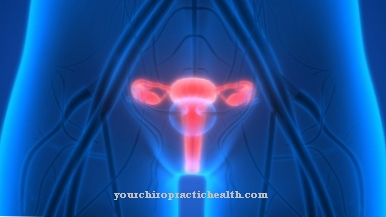As Action potential this is a short-term change in membrane potential. Action potentials typically arise on the axon hill of a nerve cell and are the prerequisite for stimulus transmission.
What is the action potential?

The action potential is a spontaneous reversal of charge in nerve cells. Action potentials arise on the axon hill. The axon hill is the origin of the forwarding processes of a nerve cell. The action potential then migrates along the axon, i.e. the nerve process.
A potential can last anywhere from a millisecond to a few minutes. Each action potential is equally pronounced in its intensity. There are therefore neither weak nor strong action potentials. It is more about all-or-nothing reactions, that is, either a stimulus is strong enough that it can completely trigger an action potential, or the action potential is not triggered at all. Each action potential runs in several phases.
Function & task
Before the action potential, the cell is in its resting state. The sodium channels are largely closed, the potassium channels are partially open. Through the movement of the potassium ions, the cell maintains the so-called resting membrane potential in this phase. This is around -70 mV. So if you were to measure the tension inside the axon, you would get a negative potential of -70 mV. This can be traced back to a charge imbalance of the ions between the space outside the cell and the cell fluid.
The receptive appendages of the nerve cells, the dendrites, pick up stimuli and pass them on to the axon mound via the cell body. The resting membrane potential changes with every incoming stimulus. In order for an action potential to be triggered, however, a threshold value must be exceeded on the axon hill. This threshold value is only reached when the membrane potential increases by 20 mV to -50 mV. If the membrane potential only rises to -55 mV, for example, nothing happens because of the all-or-nothing reaction.
If the threshold value is exceeded, the sodium channels of the cell open. Positively charged sodium ions flow in, the resting potential continues to rise. The potassium channels close. The result is a polarization reversal. The space within the axon is now positively charged for a short time. This phase is also known as overshoot.
The sodium channels close again before the maximum membrane potential is reached. To do this, the potassium channels open and potassium ions flow out of the cell. Repolarization takes place, which means that the membrane potential again approaches the resting potential. So-called hyperpolarization even occurs for a short time. The membrane potential drops below -70 mV. This period of approximately two milliseconds is also called the refractory period. In the refractory period, it is not possible to trigger an action potential. This is to prevent over-excitability of the cell.
After the regulation by the sodium-potassium pump, the voltage is again at -70 mV and the axon can be excited again by a stimulus. The action potential is now passed on from one section of the axon to the next. Because the previous section is still in the refractory period, the stimulus can only be transmitted in one direction.
However, this continuous stimulus transmission is rather slow. The saltatory stimulus transmission is faster. The axons are surrounded by a so-called myelin sheath. This acts like a kind of insulating tape. In between, the myelin sheath is repeatedly interrupted. These breaks are known as tying rings. In the saltatory stimulus transmission, the action potentials now quasi jump from one ring to the next. This increases the forwarding speed significantly.
The action potential is the basis for forwarding stimulus information. All functions of the body are based on this transmission.
You can find your medication here
➔ Medicines for paresthesia and circulatory disordersIllnesses & ailments
If the myelin sheaths of the nerve cells are attacked and destroyed, serious disturbances in the transmission of stimuli occur. With the loss of the myelin sheath, charge is lost in transit. This means that more charge is needed to excite the axon at the next break in the myelin sheath. If the myelin layer is slightly damaged, the action potential occurs with a delay. If there is severe damage, the transmission of excitation can be completely interrupted, since no more action potential can be triggered.
The myelin sheaths can be affected by genetic defects such as Krabbe's disease or Charcot-Marie-Tooth disease. The best-known demyelinating disease is probably multiple sclerosis. Here the myelin sheaths are attacked and destroyed by the body's own defense cells. Depending on which nerves are affected, visual disturbances, general weakness, spasticity, paralysis, sensitivity or language disorders can occur.
Paramyotonia congenita is a rather rare disease. On average, only one person out of 250,000 is affected. The condition is a disorder of the sodium channel. As a result, the sodium ions can penetrate the cell even in phases in which the sodium channel should actually be closed and thus trigger an action potential, even if there is actually no stimulus at all. As a result, there can be permanent tension in the nerves. This is expressed by increased muscle tension (myotonia). After a voluntary movement, the muscles relax significantly after a delay.
The opposite route is also conceivable with Paramyotonia congenita. It is possible that the sodium channel does not allow sodium ions into the cell, even when excited. An action potential can only be triggered with a delay or not at all, in spite of an incoming stimulus. There is no reaction to the stimulus. The result is sensitivity disorders, muscle weakness or paralysis. The occurrence of the symptoms is particularly favored by low temperatures, which is why those affected should avoid any cooling of the muscles.
























.jpg)



